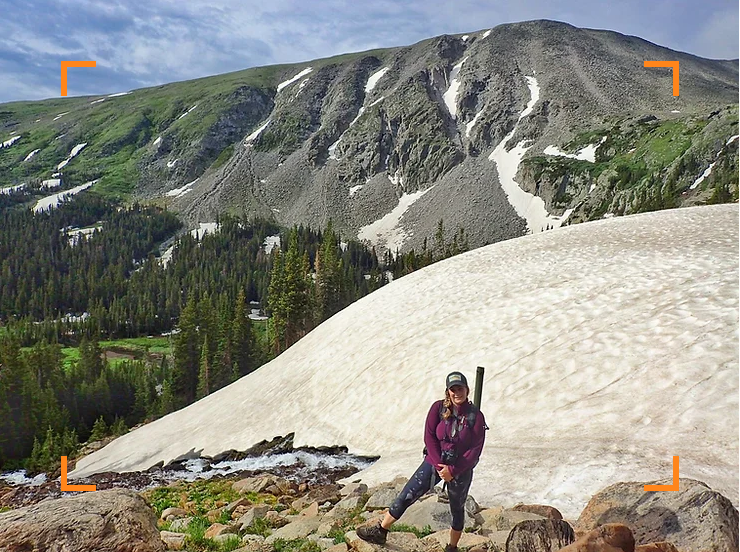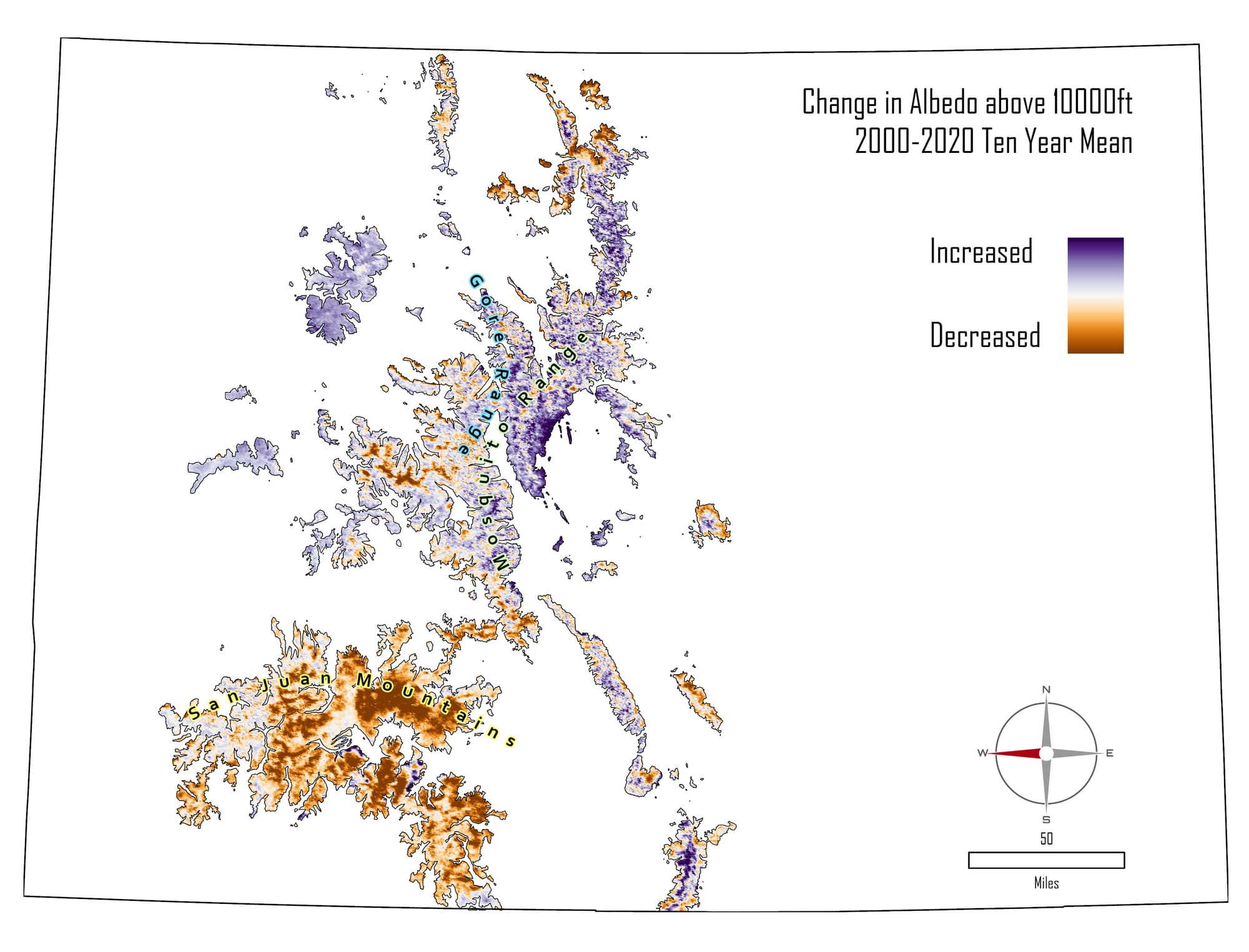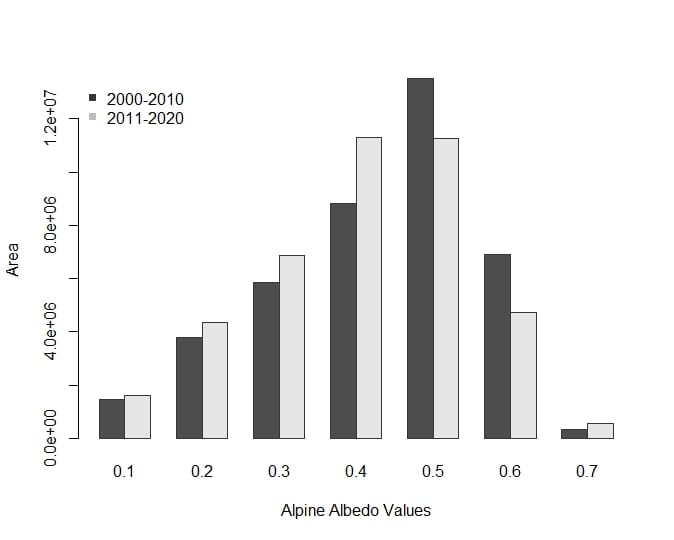Alpine Ice-Off: Raining Dust
We discuss a phenomenon that's causing earlier spring snowmelt

April 2021
In the last article, we explored when to expect snow-free conditions in an alpine environment (above 10,000ft elevation). If you haven't checked out that article, go read it first! We found a few trends that are worthy of greater exploration. First, we noticed that the average first snow-free date was gradually occurring earlier over time for elevations greater than 7,500ft. But we didn't find the same results when looking at elevations only 10,000ft or greater. Why? We all (should) know temperatures are rising, but the warming effects haven't quite reached the highest peaks. Though some small temperature increases have been recorded at increasingly higher elevations, the effects aren't as significant in the highest alpine environments (yet). But there is another phenomenon that's causing earlier snowmelt which we didn't really discuss in the previous article. The cause: airborne dust from human activities that decrease the albedo of the snow.
Wait, wtf is albedo?
Albedo describes the reflectivity of the surface of an object, and the ability of it to reflect or absorb the visible and infrared light (energy) from the sun. A good example is black asphalt in Arizona during the summer. You can cook an egg on its surface because it has a low albedo (close to 0), which absorbs nearly all of the energy from the sun and then converts the energy to heat (thanks to the First Law of Thermodynamics). Snow has a high albedo with a strong ability to reflect sunlight, whereas asphalt has a low albedo. Usually, ice from glaciers and winter snowpack reflect sunlight well and thus slow the spring thaw. The gradual melting is what provides sustained cool water to rivers throughout the summer season and helps prevent large downstream spring flooding events. If this pulse happens earlier in the year, our rivers shed their reserve water faster, reaching base flow sooner in the year. When all the snowmelt is gone before the hottest part of summer, it's likely to increase stream temperatures, and even stress trout. Luckily, snow reflects sunlight well.
But what would happens when something darker (i.e., has a lower albedo) settles on the snow? What kind of substance would cause a decrease in snow albedo?
Cue burning carbon (i.e. mega wildfires), industrial food production, clear-cutting forests, land development, desertification, and mega-droughts. Each creates and stirs up soot, dust, or other dark absorptive particles which swirl high into the atmosphere and later deposit on top of snow far from their source. Once temperatures begin to warm in the spring, the dark dusty particles that fell with or settled upon the snow reduce the reflective surface and cause faster rates of snowmelt. Scientists have documented evidence that human-derived particles are decreasing alpine snow albedo causing earlier spring peak runoff. These effects are seen all across the West and have led to some concerns about how water will be provided to downstream states, furthest from the snowmelt source. When scientists specifically looked at these effects of the Colorado River around Lee's Ferry, Arizona, they found that dust had accelerated spring peak runoff by several weeks, coupled with enough evaporation to decrease annual flow by 5%. They also estimated that the 5% loss would be enough to water Las Vegas for 18 months! So we're not talking about small amounts; the influence of human-induced dust is concerning for many western water managers, though the problem persists globally, too. Similar reports have been documented in the world's most famous mountain range: the Himalayas.
Can we actually track changes to albedo?
As with the last article, we again turned to the earth observation satellite, MODIS, to help tap into the vast collection of land cover imagery. (Thanks big brother). We compared Colorado's mean daily albedo for for the years between 2000-2010 to the mean daily albedo for all years between 2011-2020. Albedo is measured from 0 to 1, where surfaces with a value of 0 absorb sunlight best (perfect absorbers), and areas with a value of 1 reflect sunlight best (perfect reflectors). In other words, 0 = darkest possible surface, 1 = lightest possible surface.
If you look at only areas above 10,000ft, the earlier range of years had a max albedo of 0.7 compared to a max albedo of 0.67 for the later range of years. Similarly, the mean albedo for the earlier range was 0.375, and decreased to 0.355 over the later range of years. So there are some indications that albedo is decreasing. But the decreases weren't evenly distributed across Colorado. The greatest loss in albedo occurred in the San Juan Mountain Range in the southern part of the State, while other areas, like the Gore Range, Mosquito Range, and Flat Tops saw some increases.

These trends are highly variable, as yearly climate patterns frequently oscillate. Plus, drought plays an obvious role in determining snowfall, and we've seen our share of droughts in the last 20 years. Lack of snow and warming temperatures all play into a positive feedback loop affecting the timing of our spring peak runoffs. Let's think big picture for a moment. If the global albedo is lowered, more solar energy becomes absorbed, causing more warming, and leads to further albedo reductions. This leads back to greater warming and the loop repeats. Again. And again. And again....

Why the focus above 10,000ft?
Global rising temperatures are least observed at the highest altitudes, so changes in albedo at these elevations suggest that even though temperature increases from climate change aren't noticeable in the high alpine zone, the deposition of low-albedo particles distributed throughout the atmosphere are raining down with similar warming impacts. Not only are temperature increases creeping upwards in altitude, but they are being reinforced by particles raining down from above.
Are there solutions?
Is there anything that can be done to slow the early release of spring runoff? Possibly a way to retain the water rolling downstream without getting immediately shoved into large reservoirs, where hot summer temperatures bake-off and evaporate that precious water before being used? In our next article, we will highlight an unlikely hero who has some ideas about slowing water as it runs downstream that might to mitigate the effects of a premature spring thaw.
Sources:
- Rassler, B. 2018. It's Not Just High Temps Messing with Snow—It's Dust. Outside Magazine. https://www.outsideonline.com/2275956/its-not-just-high-temps-messing-snow-its-dust
- CIRES. 2018. Robbing The West. Cooperative Institute for Research in Environmental Science, University of Colorado, Boulder. http://cires1.colorado.edu/science/spheres/snow-ice/dust-on-snow.html
- My NASA Data. Changing Albedo Values. https://mynasadata.larc.nasa.gov/basic-page/changing-albedo-values
- NASA. Measuring Earth's Albedo. https://earthobservatory.nasa.gov/images/84499/measuring-earths-albedo#:~:text=Using%20satellite%20measurements%20accumulated%20since,%2C%20and%20December%2031%2C%202011.
- Roberts, L. 2020. Dust May Beat Black Carbon at Speeding Up Snowmelt in the Himalayas. https://blogs.ei.columbia.edu/2020/12/03/dust-speeds-snowmelt-himalayas/
- NIDIS. 2021. Drought in Colorado from 2000–Present. https://www.drought.gov/states/colorado#:~:text=Drought%20in%20Colorado%20from%202000%E2%80%93Present&text=Since%202000%2C%20the%20longest%20duration,affected%2034.37%25%20of%20Colorado%20land.


